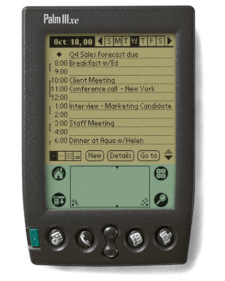PDA
Stands for "Personal Digital Assistant."
A PDA is a small, handheld electronic computer for keeping and organizing personal information. Someone could use a PDA to keep their appointment calendar, write notes, manage an address book, and keep other personal data handy wherever they went. A PDA synced with its user's computer using a serial, USB, or Bluetooth connection to add files and keep data up-to-date. Several PDA platforms (primarily PalmOS and Windows Mobile) were common in the late 1990s and early 2000s, but they declined and disappeared after the introduction of smartphones running iOS and Android.
PDAs used low-resolution resistive touchscreens that required you to tap with a stylus to interact with it. You would tap on an app icon to launch that app, tap buttons to trigger commands, and even tap tiny keys on an on-screen virtual keyboard to enter text. Most PDAs also supported some form of handwriting recognition for text input; for example, PalmOS devices used an alphabet called Graffiti that allowed users to write text, letter by letter, using simplified glyphs.
The primary use for a PDA was as a digital organizer to replace a paper address book, calendar, notepad, and to-do list. Each PDA platform included a basic suite of built-in apps for most tasks and allowed you to install third-party software to add new features (and to play some games). Later models of PDA included Wi-Fi connectivity to access the Internet, although most were limited to email, instant messaging, and basic web browsing.
The first mainstream PDA was the Apple Newton, released in 1993. It failed to catch on since the handwriting recognition at release was unreliable, and Apple abandoned the platform in 1998. The 3Com Palm Pilot, released in 1996, was the first PDA to achieve widespread success thanks to its simplicity and easy-to-learn Graffiti writing system. After Palm devices proved PDAs could be successful, Microsoft released the Windows Mobile operating system for Pocket PC devices like the HP iPAQ and Toshiba e800. Finally, the original BlackBerry PDA devices set themselves apart by using small physical keyboards and could connect to a cellular phone network to send and receive email messages.
 Test Your Knowledge
Test Your Knowledge